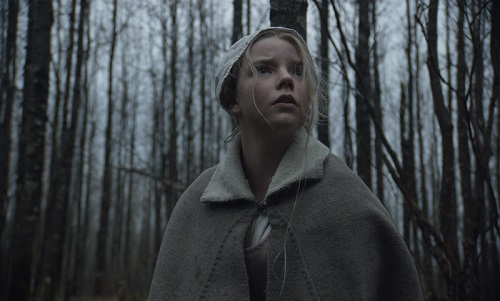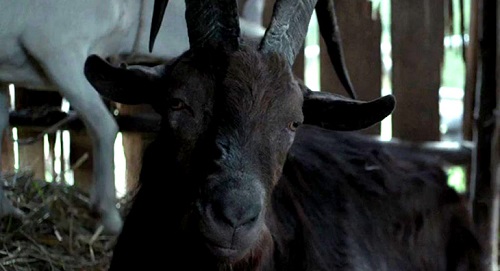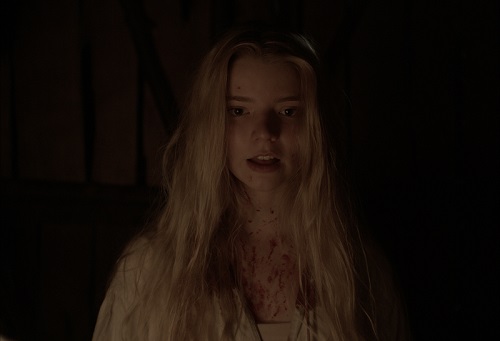Synopsis: A family in 1630s New England is torn apart by the forces of witchcraft, black magic and possession.
Release Date: February 19, 2016 MPAA Rating: PG-13
Genre(s): Horror,
Film Review

Production
Ever since writer/director Robert Eggers’ The Witch made its premiere at last year’s Sundance Film Festival, it has been one of the most anticipated and buzzworthy movies in the horror community. After a year on the festival circuit where it played heavyweight fests like Fantastic Fest, The Toronto International Film Festival, and the Melbourne International Film Festival, The Witch is finally getting a wide release. And fortunately for it, The Witch lives up to its hype.
Set in the mid-1600s, The Witch (or as it is coolly stylized, The VVitch) is about a family who, after being banished by the church from their township, ventures out into the New England countryside to build a new life. They seem to find the perfect clearing on the edge of a thick wood to call home, but something is not right about the place. When the youngest child, a mere baby, disappears, parents William and Katherine (Ralph Ineson and Kate Dickie, both from “Game of Thrones”) are justifiably concerned, but eldest daughter Thomasin (Anya Taylor-Joy from “Atlantis”) jokes with the younger kids about a witch in the woods who stole the baby away. Of course, this alarms the parents even more, and they start to think that their own daughter may be possessed by the devil. One thing that they are sure of, though, is that there is something in the woods, supernatural presence or not, that is watching and tormenting the family.

The Witch is an amazing exercise in suspicion and paranoia. Forget the titular witch (who may or may not actually exist), the real antagonist in the film is the family’s own doubts and fears. A big part of what makes the film so effective is what is not shown; there are holes in the story, but they are perfectly placed to arouse mistrust and doubt in the audience as well as in the characters. In one scene, for example, Thomasin frightens the younger kids by slowly approaching them and chanting a creepy cadence, seemingly just to toy with them, but the performance is so convincing that even the audience has to wonder how much of it is a joke and how much of it is based in reality – is Thomasin, in fact, the root of all of the family’s problems?
As one could probably guess, The Witch is a period movie, and that fact works both for it and against it. Eggers and his creative team went to great lengths to ensure authenticity in the film, so everything from the locations and cinematography to the costuming and production design give the viewer the feeling that they are looking back into 17th century New England. Unfortunately, that authenticity is also present in the colonial era dialog, which can be a bit hard to understand at times. It’s all done for the sake of historical accuracy, however, so, regardless of its occult themes and content, The Witch really does feel like a slice of American history.

It’s worth noting that, as much of a breakthrough performance as Anya Taylor-Joy gives in the role of Thomasin, she’s not the big star of The Witch. One of the family’s goats, an evil-looking fellow named Black Phillip, actually steals the movie. Whether he’s jumping around on his hind legs or just staring into the camera with what looks like a smug grin on his face, Black Phillip runs away with every scene he’s in (both literally and figuratively). If there was an Academy Award for Best Animal Actor, it would have to go to Black Phillip (or Charlie, the real-life goat who plays him).
What The Witch boils down to is that it’s a modern movie, set in the 1600s, that feels like one of those creepy seventies occult flicks, right down to the crazily ambiguous final scene. But it is also much more than all of that. It’s a tense and disturbing tale about one family’s fight for survival against both the natural elements and the possibility of supernatural interference. It’s also about that family’s search for itself and its eventual breakdown due to what it does (or does not) find. Or it could just be about a satanic goat. Any way you want to frame it, The Witch is a fantastic movie.

Cinematography
The Witch was shot by cinematographer Jarin Blaschke (Blood Night: The Legend of Mary Hatchet) in the forests of Northern Ontario, which does a pretty good job at looking like the untouched beauty of 17th century New England. There are a handful of cool photographic tricks that Blaschke used to give the film its very distinct look. First off, the film was shot in a format that is close to a 4:3 aspect ratio, a decision that exaggerates the height of the trees in the woods, making the humans look very small in comparison. Blaschke also used lenses with shallow depth-of-field so that very little of the actual screen image ends up in focus, resulting in the film looking much like the human eye would see the events in real life. Keeping with the natural look, the lighting is all directional and motivated, another factor that helps the film to look authentic to the time period. Jarin Blaschke’s cinematography is just one of the quality elements in the perfect storm of The Witch.

Score and Soundtrack
Another of the quality elements in The Witch is the musical score. Composer Mark Korven (Cube) went out of his way to obtain and write for period instruments like the nyckelharpa (basically a fiddle) and the jouhikko (a type of lyre), as well as some of the more common old contraptions such as the waterphone and the hurdy gurdy, so the soundtrack has a truly authentic vibe. That doesn’t mean that the score for The Witch is period music, however; it’s full of shrieking and moaning sounds, abrasive and atonal, that are anything but 17th century. Korven also used a local Toronto new age choir called The Element Choir to add some eerie ethereal voices to his morbid score. The whole thing adds up to a disturbing, unsettling aural assault that keeps the audience squirming in its collective seat. Honestly, if the music for The Witch had been written in the 17th century, Korven would have probably been persecuted for making the Devil’s music. So, it’s perfect. Forgive the pun, but The Witch has one hell of a score.


Scary Factor
Those who go into The Witch expecting to have the pants scared off of them are going to be disappointed. It’s not that it isn’t scary, it’s just that it’s a less-traditional type of fear. There’s not a single jump scare in the entire movie. Instead, The Witch simmers on an uncomfortable note, lulling the viewer into a false sense of comfort without letting them ever fully settle down. It’s that kind of scary; no real jumps, but plenty of shivers, and a whole lot of creep-out. The Witch isn’t going to make anyone scream out loud, but it’s not going to let them relax in their chair, either.
Cast and Crew
- Director(s): Robert Eggers
- Producer(s): Daniel BekermanLars KnudsenJodi RedmondRodrigo TeixeiraJay Van Hoy
- Screenwriter(s): Robert Eggers
- Story:
- Cast: Anya Taylor-Joy (Thomasin)Ralph Ineson (William)Kate Dickie (Katherine) Harvey Scrimshaw (Caleb)Ellie Grainger (Mercy)Mucas Dawson (Jonas)Bathsheba Garnett (The Witch)Sarah Stephens (Young Witch)Julian Richings (Governor)Wahab Chaudhry (Black Phillip)
- Editor(s): Louise Ford
- Cinematographer: Jarin Blaschke
- Production Designer(s):
- Costume Designer: Linda Muir
- Casting Director(s): John BuchanKharmel CochraneJason Knight
- Music Score: Mark Korven
- Music Performed By:
- Country Of Origin: USAUK
